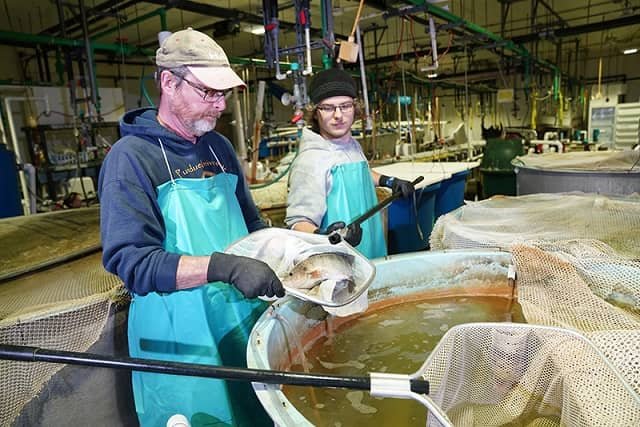
For shrimp farms utilizing Recirculating Aquaculture Systems (RAS), wastewater can be a significant environmental concern. New research suggests a promising solution: microalgae-based wastewater treatment. This innovative approach not only cleans wastewater but also offers environmental benefits compared to traditional methods.
Researchers at Purdue University (USA) conducted a Life Cycle Assessment (LCA) to analyze the environmental impact of integrating microalgae treatment into Recirculating Aquaculture Systems (RAS) for shrimp farming. This approach evaluates the environmental footprint of a product or process throughout its lifecycle.
The challenge of Recirculating Aquaculture Systems (RAS)
- 1 The challenge of Recirculating Aquaculture Systems (RAS)
- 2 Conventional treatment methods: limitations exist
- 3 The problem: traditional wastewater treatment
- 4 Microalgae: the alternative for effluent treatment
- 5 Process optimization for sustainability
- 6 Challenges and Opportunities for Microalgae Integration
- 7 Conclusion
- 8 Entradas relacionadas:
RAS are indoor systems that reuse water, minimizing water usage and maximizing seafood production. However, these high-density systems have a drawback: waste accumulation. Uneaten feeds and animal waste accumulate, leading to:
- Sludge formation: Decomposing organic matter creates sludge, releasing harmful nutrients like ammonia and nitrates.
- Reduced oxygen levels: This sludge decomposition depletes vital oxygen necessary for healthy shrimp growth.
- Environmental impact: When released untreated, these nutrients can pollute surrounding water bodies and cause eutrophication.
Conventional treatment methods: limitations exist
Traditional wastewater treatment methods, such as sedimentation and bioreactors, can only remove specific contaminants. While wetlands and activated sludge can handle all waste components, they have disadvantages:
- Limited scope: Traditional methods may not address all environmental concerns, such as greenhouse gas emissions.
- High operational costs: Maintaining and operating these systems can be expensive.
The problem: traditional wastewater treatment
While traditional methods remove some contaminants, they may still contribute to:
- Freshwater pollution: Excess nutrients in wastewater can harm freshwater ecosystems.
- Marine pollution: Nutrient runoff can also negatively impact coastal ecosystems.
- Greenhouse gas emissions: Treatment processes often require significant energy input.
Microalgae: the alternative for effluent treatment
Microalgae are microscopic aquatic plants emerging as a revolutionary method for aquaculture wastewater treatment. Here’s what makes them promising:
- Wastewater cleaning: Microalgae absorb nutrients like nitrogen and phosphorus while cleaning water.
- Biomass production: Absorbed nutrients are utilized by microalgae to grow, creating valuable biomass.
- Biogas potential: This biomass can be converted into biogas, creating an additional income source.
- Greenhouse gas reduction: Microalgae photosynthesis consumes carbon dioxide, mitigating greenhouse gas impact.
The study found that microalgae treatment significantly reduced environmental impact compared to traditional methods:
- Eutrophication reduction: Microalgae treatment generated less than 10% of the Freshwater Eutrophication Potential (FEP) and Marine Eutrophication Potential (MEP) compared to the overall RAS system. Eutrophication occurs when excess nutrients contaminate water bodies, leading to harmful algae proliferation.
- Lower global warming potential: Microalgae treatment also contributed less to the global warming potential compared to traditional methods. However, the study highlights that electricity usage remains a key factor.
Process optimization for sustainability
The research suggests additional improvements for even greater environmental benefits:
Stay Always Informed
Join our communities to instantly receive the most important news, reports, and analysis from the aquaculture industry.
- Renewable energy: Replacing fossil fuels with renewable energy sources like solar or wind in RAS systems can drastically reduce their environmental footprint (between 90% and 99%).
- Biomass utilization: While using microalgae biomass for biogas production showed promise in reducing MEP, its use for feed ingredients or biodiesel was not beneficial to the environment. Further research is needed in these areas.
Challenges and Opportunities for Microalgae Integration
Despite these benefits, scaling up microalgae treatment faces obstacles:
- Strain selection: Choosing the optimal microalgae strain for efficient wastewater treatment requires further research.
- Resource and energy inputs: Microalgae cultivation requires additional resources and energy, affecting operational costs.
Conclusion
“This study demonstrated that using microalgae for aquaculture wastewater treatment is environmentally viable; the results can guide more sustainable RAS operations and large-scale microalgae treatment design,” concluded the researchers.
Microalgae offers a promising and environmentally friendly solution for shrimp aquaculture wastewater treatment. Further research and optimization can unlock the full potential of this innovative approach.
This study showcases the environmental benefits of microalgae-based wastewater treatment in RAS. By adopting this approach and incorporating renewable energy sources, shrimp farms can significantly reduce their environmental footprint. The findings pave the way for designing more sustainable large-scale microalgae treatment systems.
The study was funded by USDA National Institute of Food and Agriculture.
Contact
Jen-Yi Huang
Department of Food Science, Purdue University
745 Agriculture Mall Drive, West Lafayette, IN 47907, USA.
Email: huang874@purdue.edu
Reference
Arbour, A. J., Bhatt, P., Simsek, H., Brown, P. B., & Huang, J. (2024). Life cycle assessment on environmental feasibility of microalgae-based wastewater treatment for shrimp recirculating aquaculture systems. Bioresource Technology, 399, 130578. https://doi.org/10.1016/j.biortech.2024.130578
Editor at the digital magazine AquaHoy. He holds a degree in Aquaculture Biology from the National University of Santa (UNS) and a Master’s degree in Science and Innovation Management from the Polytechnic University of Valencia, with postgraduate diplomas in Business Innovation and Innovation Management. He possesses extensive experience in the aquaculture and fisheries sector, having led the Fisheries Innovation Unit of the National Program for Innovation in Fisheries and Aquaculture (PNIPA). He has served as a senior consultant in technology watch, an innovation project formulator and advisor, and a lecturer at UNS. He is a member of the Peruvian College of Biologists and was recognized by the World Aquaculture Society (WAS) in 2016 for his contribution to aquaculture.




